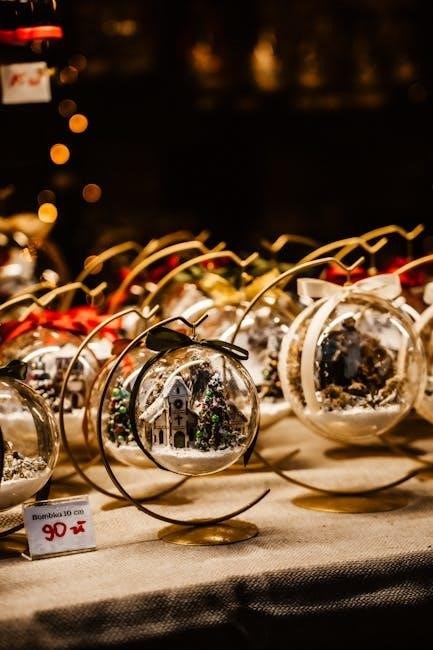Hazel-Atlas Glass is a beloved collectible, with its rich history and diverse designs․ The second edition guide by Gene and Cathy Florence offers detailed identification, vibrant photos, and updated valuations, making it an essential resource for collectors and enthusiasts alike․
Overview of Hazel-Atlas Glass Company
Hazel-Atlas Glass Company was established in 1902 through the merger of Hazel Glass Company and Atlas Glass and Metal Company in Washington, Pennsylvania․ Known for producing high-quality glassware, the company specialized in a wide range of products, including children’s dishes, tumblers, food containers, and decorative items․ Hazel-Atlas became a prominent name in the glassware industry, catering to both functional and aesthetic needs․ The company’s products were durable, versatile, and affordable, making them popular among households․ Their glassware often featured unique patterns and designs, which are now highly sought after by collectors․ The company’s legacy is marked by its contribution to mid-century glassware trends and its enduring appeal to enthusiasts today․
Importance of Identification and Valuation
Identifying and valuing Hazel-Atlas Glass is crucial for collectors and enthusiasts to understand its historical significance and monetary worth․ The second edition guide by Gene and Cathy Florence provides detailed descriptions, color photographs, and updated valuations, helping readers distinguish authentic pieces from reproductions․ Accurate identification ensures collectors can appreciate the craftsmanship and rarity of their items․ Valuation guides also empower buyers and sellers to make informed decisions in the market․ With Hazel-Atlas Glass spanning various categories, proper identification and valuation are essential for building and maintaining a meaningful collection․ This knowledge bridges the gap between hobbyists and serious collectors, fostering a deeper appreciation for the glassware’s legacy․
Structure of the Guide

The Hazel-Atlas Glass Identification and Value Guide is organized into clear categories, such as children’s dishes, tumblers, food containers, and patterns, making it easy to navigate․ Each section features detailed color photographs, descriptions, and historical context, along with updated valuation notes․ The guide also includes a handy index, a new addition in the second edition, which helps readers quickly locate specific items․ This structured approach ensures that collectors and enthusiasts can efficiently identify and value their Hazel-Atlas Glass pieces․ The comprehensive format caters to both beginners and experienced collectors, providing a thorough reference for understanding and appreciating this iconic glassware․

History of Hazel-Atlas Glass
Hazel-Atlas Glass originated from the 1902 merger of Hazel Glass and Atlas Glass, producing iconic jars, containers, and household items․ The guide details their history and evolution․
Founding and Evolution of the Company
Hazel-Atlas Glass was established in 1902 through the merger of Hazel Glass Company and Atlas Glass and Metal Company in Washington, Pennsylvania․ The company quickly became renowned for producing high-quality glassware, including jars, containers, and household items․ Known for its innovative techniques and durable products, Hazel-Atlas gained a strong reputation in the industry․ Over the years, the company expanded its product line, adapting to changing consumer needs while maintaining its commitment to excellence․ By the mid-20th century, Hazel-Atlas had become a trusted name, synonymous with reliability and craftsmanship, leaving a lasting legacy in the glassware industry․
Key Periods in Hazel-Atlas Production
Hazel-Atlas Glass production spanned several significant eras, with its heyday in the early to mid-20th century․ The company began producing glassware in 1902, focusing on functional items like jars and containers; By the 1920s, it expanded into household glassware, including tumblers and kitchenware․ The mid-20th century saw the introduction of popular patterns and designs, making Hazel-Atlas a leader in the industry․ Production continued through the 1960s and 1970s, with a shift toward more decorative and specialty items․ These key periods are crucial for collectors, as they help date and value pieces, with certain eras being more sought after due to their rarity and historical significance․
Impact on the Glassware Industry
Hazel-Atlas Glass played a pivotal role in shaping the glassware industry, particularly during the mid-20th century․ Known for its innovative designs and functional pieces, the company set trends that influenced both everyday household items and decorative glassware․ Hazel-Atlas popularized patterns like children’s dishes and tumblers, making them accessible and affordable for the masses․ Their production techniques and emphasis on durability helped standardize glassware manufacturing․ The company’s contributions also spurred the collectibles market, with many of its pieces becoming highly sought after by collectors․ Hazel-Atlas’s legacy endures as a testament to its enduring impact on the glassware industry’s evolution and design trends․

Identifying Hazel-Atlas Glass
Hazel-Atlas Glass is easily identifiable through its distinctive marks, patterns, and designs․ The Florence guide provides detailed photos and descriptions, organized by categories like children’s dishes and tumblers, aiding collectors in accurate identification and valuation․
Common Marks and Signatures
Hazel-Atlas Glass often features distinctive marks, such as an “H” inside a circle or an underlined “HA,” which help identify its origin․ These marks are typically found on the base or back of pieces․ The Florence guide highlights these signatures, providing collectors with a clear reference for authentication․ While some pieces may lack explicit markings, the company’s unique patterns and designs often serve as identifiers․ The guide also includes detailed photos of these marks, aiding collectors in distinguishing Hazel-Atlas glass from other manufacturers․ Understanding these signatures is crucial for accurate identification and valuation, making them a cornerstone of Hazel-Atlas glass collecting․
Patterns and Designs Unique to Hazel-Atlas
Hazel-Atlas Glass is renowned for its distinctive patterns and designs, which set it apart from other glassmakers․ The Florence guide showcases iconic designs like the “Miss America” and “Ripple” patterns, offering detailed descriptions and vibrant photos․ These designs often feature intricate details and vibrant color palettes, making them highly sought after by collectors․ The guide also highlights the variety of shapes and styles, from delicate tumblers to sturdy kitchenware, providing a comprehensive overview of Hazel-Atlas’s creative output․ By focusing on these unique patterns, collectors can better identify and appreciate the craftsmanship behind each piece, making the guide an indispensable tool for enthusiasts․

Distinguishing Features from Other Glassmakers
Hazel-Atlas Glass can be identified by its unique manufacturing marks, such as the “H” or “HA” logo often found on the base of pieces․ Unlike other glassmakers, Hazel-Atlas frequently used vibrant colors and bold patterns, making their designs stand out․ The glassware is also known for its durability and practicality, with heavier construction compared to competitors․ Additionally, Hazel-Atlas produced a wide range of functional and decorative items, from children’s dishes to elegant servingware, which sets it apart from more specialized manufacturers․ These distinguishing features, detailed in the Florence guide, help collectors accurately identify and value Hazel-Atlas pieces in the marketplace․

Value Guide for Hazel-Atlas Glass
The Florence guide provides detailed valuations, highlighting factors like rarity, condition, and demand․ It helps collectors determine the worth of Hazel-Atlas pieces, from common to rare items․
Factors Affecting Value
The value of Hazel-Atlas Glass is influenced by several key factors․ Rarity and condition play significant roles, with flawless, uncommon pieces commanding higher prices․ Demand, driven by collector interest, also impacts value․ Age and historical significance contribute, as older items are often more sought after․ The presence of original packaging or labels can enhance worth․ Additionally, specific patterns and colors, such as those with unique designs or limited production runs, tend to be more valuable․ Market trends and the reputation of the seller or marketplace can also affect pricing․ Understanding these factors helps collectors and enthusiasts accurately assess and appreciate their Hazel-Atlas Glass pieces․
Current Market Trends and Pricing
The current market for Hazel-Atlas Glass reflects strong demand, particularly for rare and vintage pieces․ Prices have seen a steady increase due to growing collector interest and the limited availability of certain items․ The second edition of the Florence guide provides updated valuations, helping collectors assess the worth of their pieces․ While some categories, like children’s dishes, remain affordable, rare patterns and specialty items command higher prices․ Online marketplaces and auctions continue to drive visibility and competition, influencing pricing trends․ Collectors are encouraged to stay informed about market fluctuations and utilize trusted resources for accurate appraisals of their Hazel-Atlas Glass collections․
Rare and Highly Valuable Pieces
Rare Hazel-Atlas Glass pieces, such as the Royal Lace and Moderne patterns, are highly sought after by collectors․ These items often feature intricate designs and limited production runs, significantly increasing their value․ The second edition of the Florence guide highlights these rare finds, providing detailed descriptions and updated valuations․ Condition plays a crucial role in determining worth, with flawless pieces commanding premium prices․ Collectors should look for pieces with original packaging or documentation, as these can greatly enhance value․ Auctions and estate sales are key sources for discovering these treasures, making them a thrilling hunt for enthusiasts․

Popular Hazel-Atlas Glassware Categories
Hazel-Atlas Glassware includes children’s dishes, tumblers, food containers, and decorative items․ These categories offer a variety of patterns and designs, making them highly collectible and sought after․
Children’s Dishes and Tumblers
Children’s dishes and tumblers are among the most charming Hazel-Atlas Glassware categories․ These pieces, often featuring colorful, whimsical designs, were popular in the mid-20th century․ The glassware was durable, making it practical for everyday use while appealing to children with playful patterns․ Many tumblers and dishes showcased cartoon characters or festive motifs, adding to their charm․ The Florence guide highlights these items, providing detailed photos and valuations․ Collectors prize rare examples, such as those with unique designs or in excellent condition․ The guide’s organization by category makes it easy to identify and value these delightful pieces, helping enthusiasts build or expand their collections with confidence․
Food Containers and Kitchenware
Food containers and kitchenware are a significant part of Hazel-Atlas Glass’s legacy, offering both functionality and timeless style․ The company produced a wide range of items, including canisters, jars, and refrigerator dishes, designed for everyday use․ These pieces were known for their durability and practicality, often featuring tight-fitting lids and clear glass construction․ The Florence guide provides detailed insights into these kitchen essentials, showcasing their designs, materials, and historical context․ Collectors appreciate the variety of patterns and sizes, with certain rare pieces commanding higher values․ The guide’s organization by category helps enthusiasts identify and value these items, making it easier to expand their collections with authentic Hazel-Atlas kitchenware․
Decorative and Specialty Items
Decorative and specialty items from Hazel-Atlas Glass are highly sought after for their unique designs and craftsmanship․ These pieces, such as elegant vases, intricate tumblers, and ornate serving dishes, showcase the company’s ability to blend functionality with artistic flair; The Florence guide highlights these items with detailed descriptions and vibrant photographs, making it easier for collectors to identify rare and valuable pieces․ Many of these items were produced in limited quantities, adding to their desirability․ The guide also provides insights into the historical context and production periods, helping enthusiasts understand the significance of these decorative treasures․ This section is a must-reference for those seeking to expand their collections with Hazel-Atlas’s most beautiful and distinctive creations․

Notable Patterns and Collections
Hazel-Atlas Glass is renowned for its iconic patterns and collections, such as children’s dishes, tumblers, and food containers․ The Florence guide details these designs with vibrant photos and valuations, helping collectors identify rare and sought-after pieces․ Limited editions and special releases are also highlighted, making this guide an indispensable resource for enthusiasts seeking to expand their collections with Hazel-Atlas’s most cherished creations․
Famous Hazel-Atlas Patterns
Hazel-Atlas Glass is celebrated for its iconic patterns, many of which have become highly sought after by collectors․ The Florence guide showcases designs like children’s dishes featuring beloved cartoon characters, vibrant tumblers, and elegant kitchenware․ Patterns such as “Miss Kitty,” “Popeye,” and “Owl,” along with geometric and floral motifs, are highlighted․ These designs, produced from the 1920s through the 1970s, reflect the company’s versatility and artistic flair․ The guide provides detailed descriptions, color photos, and valuations, making it easier to identify rare and valuable pieces․ These famous patterns remain a cornerstone of Hazel-Atlas glass collections, appealing to both seasoned collectors and newcomers alike․
Limited Edition and Special Releases
Limited Edition and Special Releases
Limited edition and special release Hazel-Atlas Glass pieces hold a unique allure for collectors․ These rare items, often produced in smaller quantities or for specific events, showcase the company’s creativity and craftsmanship․ The Florence guide highlights these special releases, offering detailed descriptions and vibrant photos to aid identification․ From commemorative designs to exclusive patterns, these pieces are highly sought after due to their rarity and historical significance․ The guide provides insights into their production timelines, design nuances, and current market values, making it an invaluable tool for collectors aiming to expand their collections with these extraordinary items․
Collector-Favorite Designs
Collector-Favorite Designs
Collector-favorite designs from Hazel-Atlas Glass are treasured for their timeless appeal and craftsmanship․ Patterns like Miss America and Royal Lace are particularly sought after, featuring intricate details and vibrant colors․ The Florence guide showcases these designs with high-quality photos, helping collectors identify authentic pieces․ These beloved patterns often reflect the era’s aesthetic trends, making them historically significant․ Their popularity endures, driving demand in the collector community․ The guide also provides insights into rarity, condition, and market demand, aiding collectors in making informed decisions․ These iconic designs remain central to Hazel-Atlas Glass collections, cherished for their beauty and nostalgic charm․

Collecting Hazel-Atlas Glass
Collecting Hazel-Atlas Glass is a rewarding hobby, with the Florence guide offering expert insights and vibrant photos to help enthusiasts identify and value their pieces effectively․
Tips for Starting a Collection
Tips for Starting a Collection
Starting a Hazel-Atlas Glass collection begins with research and understanding the market․ Use the Florence guide to identify patterns, marks, and valuations․ Examine condition carefully, as flaws can impact value․ Focus on specific categories, like children’s dishes or kitchenware, to build a cohesive collection․ Join collector communities for insights and networking․ Be patient and persistent when hunting for rare pieces․ Keep records of purchases and valuations for future reference․ Store items properly to maintain their condition․ Consider consulting experts or attending auctions to find unique pieces․ With dedication and knowledge, building a meaningful Hazel-Atlas Glass collection is both rewarding and enjoyable․
Care and Maintenance of Glassware
Care and Maintenance of Glassware
Proper care and maintenance are essential to preserve the beauty and value of Hazel-Atlas Glass․ Handle pieces with clean, dry hands to avoid fingerprints and oils․ Avoid using abrasive cleaners or scrubbers, as they can damage surfaces․ Wash items gently with mild soap and warm water, then dry thoroughly to prevent water spots․ Store glassware in a cool, dry place, away from direct sunlight, which can cause fading․ Use padded containers or dividers to protect against chipping or breaking․ Avoid exposing glass to extreme temperature changes, as this can lead to cracking․ Regular cleaning and careful storage ensure your collection remains pristine for years to come․
Displaying and Storing Your Collection
Displaying and Storing Your Collection
Displaying and storing Hazel-Atlas Glass requires careful consideration to preserve its condition and value․ For display, use glass-front cabinets or shelves to protect pieces from dust while showcasing their beauty․ Avoid direct sunlight, as it can cause fading․ Store glassware in a cool, dry environment, away from extreme temperatures․ Use padded boxes or acid-free tissue paper to prevent scratches and chips․ Label boxes for easy identification․ When storing, avoid stacking pieces to minimize risk of damage․ Consider rotating your collection periodically to ensure even exposure and prevent deterioration․ Proper display and storage practices will help maintain the integrity and appeal of your Hazel-Atlas Glass collection for years to come․

Marketplaces and Resources
Hazel-Atlas Glass can be found on platforms like Amazon, eBay, and AbeBooks․ The Florence’s guide is available at Walmart and online marketplaces, offering detailed resources for collectors and enthusiasts․
Where to Buy and Sell Hazel-Atlas Glass
Collectors can find Hazel-Atlas Glass on platforms like Amazon, eBay, and AbeBooks․ The Florence’s guide is available at Walmart and other online marketplaces, offering detailed resources․ Online communities and forums, such as WorthPoint, provide valuation tools and market insights․ Specialized collector groups and antique shops also serve as hubs for buying and selling․ These platforms often feature detailed descriptions, color photos, and expert valuations, making them invaluable for both beginners and seasoned collectors․ The guide by Gene and Cathy Florence is a trusted resource for identifying and pricing Hazel-Atlas pieces, ensuring informed decisions in the marketplace․
Recommended Books and Guides
Hazel-Atlas Glass: Identification & Value Guide, Second Edition by Gene and Cathy Florence is a must-have resource․ This comprehensive guide features detailed color photographs, organized by categories like children’s dishes, tumblers, and food containers․ It includes updated valuations, histories, and a handy index, making it indispensable for collectors․ Available on Amazon, Walmart, and AbeBooks, this book is praised for its clarity and depth․ With over 200 pages, it covers rare and common pieces, providing essential insights for identifying and valuing Hazel-Atlas glassware․ This guide is a cornerstone for anyone serious about collecting or understanding Hazel-Atlas glass․
Online Communities and Forums
Online communities and forums are invaluable resources for collectors of Hazel-Atlas glass․ Platforms like WorthPoint and specialized collector forums offer detailed discussions, identification tips, and valuation insights․ Social media groups, such as Facebook collectible communities, connect enthusiasts worldwide, fostering knowledge sharing and networking․ Reddit forums dedicated to vintage glassware also provide a space for asking questions and showcasing finds․ These digital spaces are essential for staying updated on market trends, learning from experts, and gaining access to rare or hard-to-find information about Hazel-Atlas glass․ They complement traditional guides, offering real-time interaction and a dynamic exchange of ideas among collectors․




